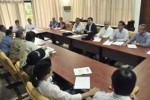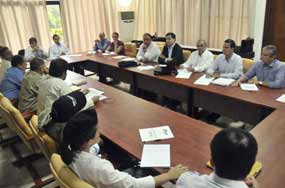 The Armed Forces of Colombia-People’s Army (FARC-EP) and the government of that country conclude another round of talks in Havana this Sunday, focused on seeking solutions to the illegal drugs problem.
The Armed Forces of Colombia-People’s Army (FARC-EP) and the government of that country conclude another round of talks in Havana this Sunday, focused on seeking solutions to the illegal drugs problem.
During the 17th round of talks, the insurgency lashed against the policy developed by the Government to fight the drugs situation, which according to FARC chief negotiator, Ivan Marquez, only fights the weak, and leave aside the key causes of the problem.
Marquez said at the beginning of the talks that FARC’s positions in relation to the issue have been historically clear, and stressed that this problem is used as an excuse for the intervention of foreign powers in the internal conflict.
FARC chief negotiator also questioned the attempts to eliminate coca plantations, and aid that the guerrilla presented a series of proposals to solve the problem once and for all.
In this round of talks, FARC also reiterated its willingness to agree to a truce with the Government for the end of the year.
Marquez added that if the Government does not agree with the possibility of a cease-fire, at least they will try the signing of a normalization agreement to reduce the effects of the war.
The guerrilla chief negotiator stated that is just a measure to force the parties in conflict to act in line with the so-called criteria of civilizations, which include a series of important regulations, such as the international humanitarian right.
It is expected that both parties present a joint communiqué today.
They reached a first agreement on the agricultural issue in late May, and a second accord about the future political participation of the insurgency was signed last November.
 Escambray ENGLISH EDITION
Escambray ENGLISH EDITION





* Shortly after World War II, the OSS (the predecessor of the CIA) formed a strategic alliance with the Sicilian and Corsican mafia.
* During the 1950s, In order to provide covert funds to forces loyal to General Chiang Kai-Shek (they were fighting the Chinese communists under Mao Zedong), the CIA helped the Kuomintang (KMT) smuggle opium to Thailand from China and Burma. They even provided planes owned by one of their front businesses—Air America.
* During the long years of the cold war, the CIA mounted major covert guerilla operations along the Soviet-Chinese border. In 1950, for their operation against communist China in northeastern Burma, and from 1965 to 1975 [during the Vietnam war] for their operation in northern Laos, the CIA recruited, as allies, people we now refer to as drug lords.
* Throughout the 1980s, in Afghanistan, the CIA’s supported the Mujahedin rebels (in their efforts against the pro-Soviet government) by facilitating their opium smuggling operations. A small local trade in opium was turned into a major source of supply for the world’s markets, including the United States. Thus Afghanistan become the largest supplier of illicit opium on the planet—a status only briefly interrupted when it was under Taliban control.
* Again during the 1980s, the Reagan administration, using cocaine smuggling operations, funded a guerrilla force known as the Nicaraguan Contras—even after such funding was outlawed by Congress. An August 1996 series in the San Jose Mercury News by Pulitzer Prize-winner Gary Webb clearly linked the origins of crack cocaine in California to the CIA and the Contras.
Follow this link to an electronic briefing book compiled from declassified documents obtained by the National Security Archive. It includes the notebooks kept by NSC aide and Iran-Contra figure Oliver North, electronic mail messages written by high-ranking Reagan administration officials, memos detailing the contra war effort and FBI and DEA reports. The documents demonstrate official knowledge of drug operations, and also collaboration with, and protection of, known drug traffickers. Court and hearing transcripts are also included.
http://www.gwu.edu/~nsarchiv/NSAEBB/NSAEBB2/nsaebb2.htm
* In November 1996, a Miami grand jury indicted former Venezuelan anti-narcotics chief, and longtime-CIA asset, General Ramon Guillen Davila. He had been smuggling many tons of cocaine into the United States from a CIA owned Venezuelan warehouse. During his trial, Guillen claimed that all of his drug smuggling operations were approved by the CIA.
* The Dirección Federal de Seguridad (DFS), a Mexican intelligence agency (spawned in 1947) was practically a creation of the CIA. DFS badges were handed out to top-level Mexican drug traffickers—thus giving them a virtual ‘License to Traffic’. The Guadalajara Cartel (Mexico’s most powerful drug-trafficking network in the early 1980s) prospered largely because it enjoyed the protection of the DFS, under its chief Miguel Nazar Haro, also a CIA asset.
For far more detailed information kindly google any of the following:
* The Big White Lie: The CIA and the Cocaine/Crack Epidemic by former DEA agent Michael Levine
* Dark Alliance: The CIA, the Contras, and the Crack Cocaine Explosion by Pulitzer Prize–winning journalist Gary Webb
* Whiteout: The CIA, Drugs and the Press by Alexander Cockburn and Jeffrey St. Clair
* The Politics of Heroin: CIA Complicity in the Global Drug Trade by Alfred W. McCoy
* The Underground Empire: Where Crime and Governments Embrace by James Mills
* Compromised: Clinton, Bush and the CIA by Terry Reed, (a former Air Force Intelligence operative) and John Cummings (a former prize-winning investigative reporter at N.Y Newsday)